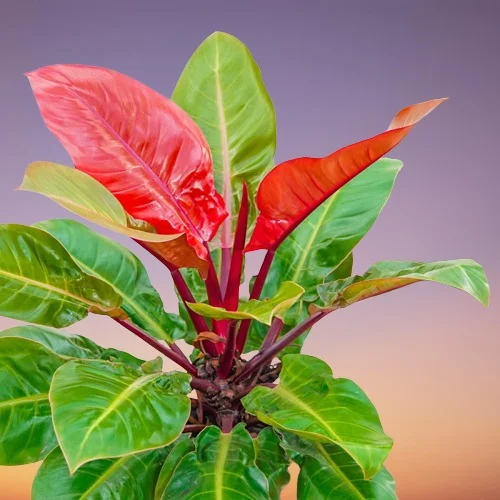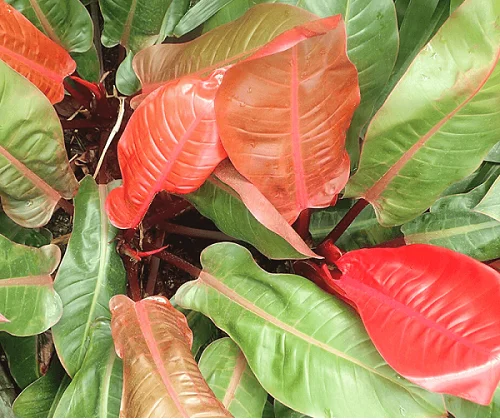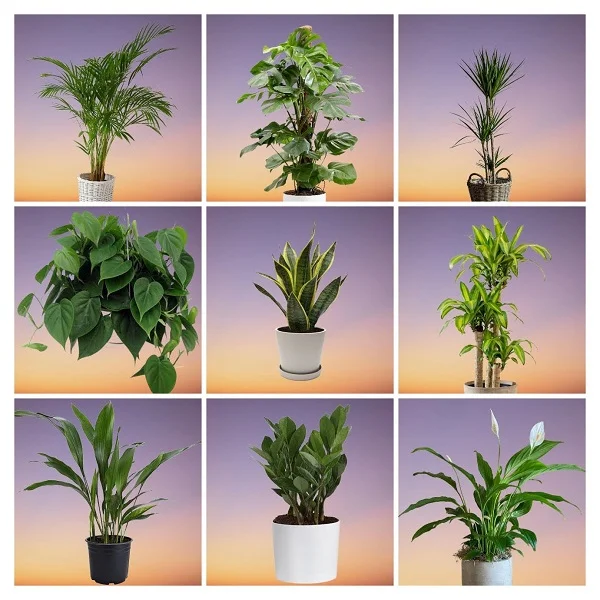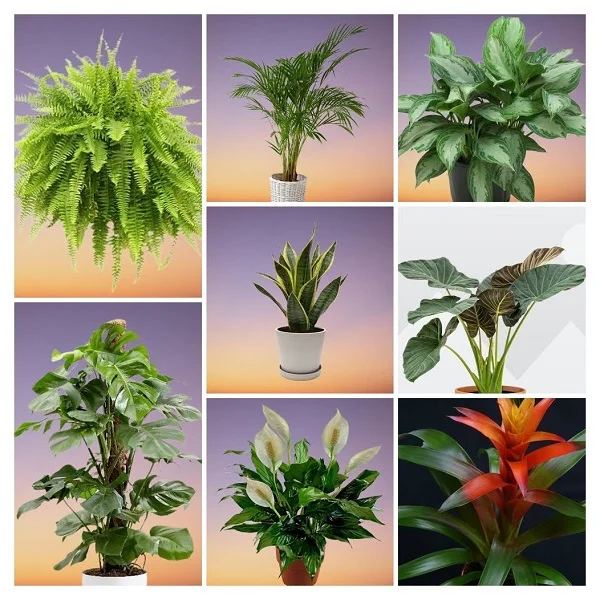Philodendron selloum 'Sun Red' Indoor Care, Propagation, Problems and Remedies
Some links in this post may be affiliate links
Philodendron Sun Red performs best in bright indirect light, warm and humid conditions and moderately moist, rich, well-drained soils coupled with monthly feeding in the growing season.
With its bold foliage and easy-care nature, this plant adds a vibrant touch to any indoor space. This guide will cover how to care for Philodendron 'Sun Red' indoors, including light, watering, propagation, and troubleshooting common issues to keep your plant thriving year-round.
Sun Red Philodendron is one of the upright, clumping Philodendron varieties whose large, oval, leathery leaves start off bright red, then burgundy or red-purple and eventually green when mature.
Philodendron Sun Red and its relatives Philodendron 'Summer Glory' and Philodendron selloum are non-climbing upright bushes which look magnificent in a pot.

Botanical name: Philodendron selloum 'Sun Red'
Family: Araceae
Common name: Philodendron Sun Red, Sun Red Philodendron
Origin
Philodendron selloum 'Sun Red' is native to the tropical rainforests of South America.
Size
Philodendron Sun Red can grow to a height of 8-10 feet but when grown indoors it rarely exceeds 4-5 feet high by the same width. On account of its size and spectacular foliage, Philodendron Philodendron selloum 'Sun Red' is among the best large low-light plants for the living room.
Is Philodendron Sun Red toxic?
As indicated by National Capital Poison Center, Philodendron Sun Red like other Philodendrons is toxic to both humans and pets. The plants contain Calcium oxalate crystals which if ingested, can cause burning and swelling in the mouth and throat, vomiting, diarrhea and abdominal pains. Therefore, keep the plant away from the reach of children and pets.
Where to buy
Should you wish to add Philodendron Sun Red to your collection, you may obtain these plants online from Etsy (Link to Etsy).
How to take care for Philodendron Sun Red indoors
To care for Philodendron Sun Red indoors give it bright indirect light (dappled light), average warmth of 18-260C, humidity of 60-70% and moderately moist, fertile, well-drained soils coupled with monthly feeding during the growing season.
Sun Red Philodendron care entails regular pruning to keep the plant neat, to encourage a bushy growth and to rejuvenate growth. Repotting for young plant when pot-bound and annual soil replacement for large plants are needed. Keep reading for more on these growing conditions and how to achieve them.

Watering
Water your Philodendron Sun Red liberally during the growing season and allow the top 2-3 inches of soil to dry out between waterings. Avoid overwatering to prevent yellowing and rotting.
Reduce the amount and frequency of watering in the cold season (fall and winter) as growth is minimal at this time. However, do not allow the soil to dry completely to avoid wilting and brown leaf edges.
Use water that is at room temperature to avoid shocking this tropical plant as it can result in slow growth and leaf drop.
To avoid soggy soil which leads to root-rot and death of the plant, ensure that the pot has a drainage hole and the soil is well-draining.
Pro tip: Use rain, filtered or distilled water to prevent salts buildup, which can damage the leaves.
Light Requirements
Philodendron Sun Red grows best in medium to bright indirect light. Keep it away from direct sunlight to avoid scorching the leaves.
If the light is too low, the plant will become leggy with small-sized pale leaves and lose leaf color. Where natural light is not adequate, you may use grow lights to supplement it.
Pro tip: For even growth and to prevent lopsided growth, turn the pot regularly to ensure that the plant receives light on all sides.
Temperature and Humidity
Philodendron Sun Red thrives in average warmth of 18-260C. Keep it away from drafts to prevent extreme temperatures. Too high temperatures may cause yellowing and leaf drop while too low temperatures can result in reduced growth or even death of the plant.
Sun Red Philodendron needs a humidity of 60-70% to thrive. Low humidity for prolonged periods can result in curled leaves and brown leaf tips and edges. To upscale humidity, set the pot on a wet pebble tray or use a humidifier.
Pro tip: Maintain good ventilation for the plant to prevent fungal diseases.
Fertilizer
Feed your Philodendron Sun Red every 4 weeks during the growing season (spring and summer) with a balanced, water-soluble fertilizer to promote a lush growth. Avoid too much fertilizer as it can lead to leggy growth.
Do not feed in the cold season (fall and winter) as growth is minimal at this time and feeding at this time can cause fertilizer burn and death of the plant.
Potting Mix
The best potting soil for Sun Red Philodendron should be well-draining, nutrient-rich soil to prevent it from getting soggy while providing the required nutrients. a blend of 50% potting soil, 30% peat moss or coco coir (for moisture retention), and 20% perlite or sand (for aeration) is ideal for this plant.
Repotting
Repot the young Philodendron Sun Red at the beginning of the growing season when the plant becomes pot-bound. Use a pot that is 2 sizes larger than the current one.
Make sure that the pot has a drainage hole to prevent the soil from getting soggy as it can lead to root-rot. Check out these ceramic pots with drainage holes on Amazon.
Replenish the top 2-3 inches of soil for large plants at the beginning of the growing season or as necessary. Take care not to injure the roots to avoid fungal infestations.
The large plants can also be divided at repotting to propagate new plants if you need to increase your collection or share with friends and family.
Pruning & Grooming
Pruning Sun Red Philodendron involves:
- Removal of yellow and dead leaves to maintain the plant neat and also reduce pest and disease infestations.
- Cutting back the stems of a straggly plant to the soil level at the beginning of the growing season to rejuvenate growth.
Once in a while, clean the leaves by damp-wiping with a soft cloth to get rid of dust and to discourage pests infestations.
Propagation
Philodendron Sun Red propagation can be done during the growing season by plant divison.
How to propagate Philodendron Sun Red by plant division
- Water the plant thoroughly at least 1 day before to make it easier to divide and also hasten establishment; a well hydrated plant suffers less shock and takes a shorter time to take root.
- Carefully remove the plant from its pot and shake off excess soil to expose the roots.
- Look for sections of stems and roots that can be easily separated.
- With a clean knife or pruning scissors, gently divide the plant into sections while ensuring each section has enough roots.
- Select a pot about 1-2 inches larger than the rootball. Ensure the pot has enough drainage holes to prevent rotting.
- Fill the pot with well-draining soil and moisten the soil slightly.
- Position the section in the center of the pots and lightly firm the soil around. Keep the section at the same level it was in the previous pot.
- Place the set up in a warm, brightly-lit place and maintain the soil moist until the new plant is well established after which you can begin routine care.

Philodendron Sun Red Problems & Solutions
Philodendron Sun Red problems are yellow leaves, brown leaves, plant dying, dropping leaves, leggy growth, brown leaf tips, loss of leaf color, pests and diseases among others. Keep reading for more on these problems and how to fix them.
Yellow leaves
Some of the causes of yellow leaves on Philodendron Sun Red are overwatering, soggy soil, direct sunlight and nutrient deficiency.
How to fix it
Overwatering: Do not water on a schedule. Water only when the top 2-3 inches of soil dry.
Soggy soil: Use a well-draining potting soil and a pot with a drainage hole.
Direct sunlight: Keep the plant away from direct sunlight or filter the sunlight with a light curtain.
Nutrient deficiency: Apply a balanced, water-soluble fertilizer every 4 weeks in spring and summer.
Brown leaves
Some of the causes of brown leaves on Philodendron Sun Red are direct sunlight, low humidity, and underwatering.
How to fix it
Direct sunlight: Keep the plant away from direct sunlight or instal a light curtain or sheer to filter the sunlight.
Low humidity: Set the pot on a wet pebble tray, use a humidifier or group the plants together.
Underwatering: Water when the top 2-3 inches of soil dry. Never allow the soil to dry out completely.
Plant dying
Why is my Philodendron selloum 'Sun Red' dying?
Your Philodendron selloum 'Sun Red' is dying due to root-rot disease which is enhanced by soggy soil. The disease is characterized by yellowing and browning which is followed by plant collapse.
How to fix it
- Remove the plant from its pot, trim rotten roots, and treat the healthy roots with a copper-based fungicidal solution.
- Repot the plant in well-draining soil and keep it dry for 5-7 days before watering to help it recover.
- Use a pot with a drainage hole and free-draining soil to prevent the soil from getting soggy.
Brown leaf tips
Brown leaf tips on Philodendron Sun Red are caused by dry air, underwatering, salts buildup, and drafts.
How to fix it
Dry air: Set the pot on a wet pebble tray or use a cool mist humidifier to raise humidity. You may also grow the plant in the humid areas in the home.
Underwatering: Maintain the soil moderately moist and do not allow the soil to dry out completely.
Salts buildup: Use rain water or filtered water. Flush out salts from the soil every 1-2 months.
Drafts: Protect or place the plant away from drafts emanating from windy doors, drafty windows, AC units, heat sources among others.
Leaf drop
Leaf drop in Philodendron Sun Red is due to age (maturity), hot temperatures, and sudden change of growing conditions.
How to fix it
Age (maturity): As the plant ages, the lower leaves will drop; this is a natural process.
Hot temperatures: Keep the plant away from hot drafts from hot air vents, heat sources and others to maintain a warmth of 18-260C.
Sudden change of the growing conditions: Avoid moving the plant before acclimating it. Move it gradually to a little brighter spot every so often over a period of time.
Leggy growth
Leggy growth in Philodendron Sun Red caused by too much shade and overfertilizing.
How to fix it
Too much shade: Move the plant to a more brighter spot or instal a grow light where natural light is not sufficient.
Overfertilizing: Take care not to overfeed; feed monthly in spring and summer, do not feed in fall and winter.
Diseases
Philodendron Sun Red is prone to powdery mildew and leaf spot disease which are promoted by overwet conditions coupled with poor air circulation.
How to fix it
- Isolate the affected plant to prevent spread to the rest of the plants and spray it with a fungicidal solution as directed by the manufacturer.
- To prevent future infestation, avoid wetting the foliage and water from the bottom instead.
- Ensure that there is good air circulation for the plant to discourage these fungal diseases.
Pests
Common pests in Philodendron Sun Red are mealybugs, scales and aphids. Isolate the affected plant to prevent spread to other plants and treat it with neem oil or insecticidal soap as recommended by the manufacturers.
Loss of leaf color
Loss of leaf color in Philodendron Sun Red is caused by too little light. Position the plant in a brighter spot or instal a grow light if the natural lighting is insufficient.
Conclusion
Philodendron selloum 'Sun Red' is a vibrant, low-maintenance plant that thrives with proper light, moderate watering, and occasional pruning. By following these care, propagation, and troubleshooting tips, your plant will remain healthy and stunning for years.
You liked it? Share on social media.
Related Content
Amazon Associates Disclosure
Homeplantsguide.com is a participant in the Amazon Services LLC Associates Program, an affiliate advertising program designed to provide a means for sites to earn advertising fees by advertising and linking to amazon.com.





